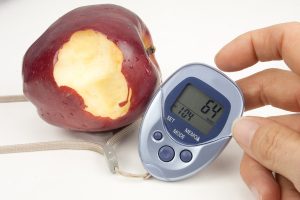Last week, Colby wrote about trends in cancer research. Here, I’d like to weigh in on trends to lower cancer risk – not predictions, but habits I’d like to see everyone do and therefore become a top trend.
1. Track your health-related habits.
Tracking helps you be aware of what, how much and when you are eating or exercising. You can then identify what changes you want to make and what would be realistic.
Use whatever method works best for you. Try paper and pencil – get a small notebook that fits in your briefcase, purse or pocket. After each meal or snack, write down everything you eat and, depending on your goal, how much you ate. There are also many phone apps or online programs that calculate calories, nutrients or other analyses.
For physical activity and fitness, you can write down your steps or minutes of activity or there are a variety of wearable devices that track distance, steps, the energy you expend and even your sleep.
We discuss a few of these apps here, but you can also sign up for our New American Plate Challenge for help with weight loss and developing more cancer-preventive habits.
2. Add one new colorful vegetable and fruit daily.
According to a Centers for Disease Control 2013 report on fruits and vegetables, U.S. adults eat fruit about once per day and vegetables 1.6 times per day. That’s far below the minimum recommendation of 5 servings per day.
You’ll beat the average if you have a piece of fruit or berries at breakfast, carrot sticks for lunch, an apple for snack and for dinner a generous serving of mixed greens, broccoli or summer squash, for example. But to meet the recommended 4-5 cups of veggies and fruit daily, if you’re like most Americans, you need to up how much you eat. For recipes to help you get more veggies and fruit, sign up to receive our weekly Health-e-Recipe.
3. Stand up and move every 30 minutes.
There’s been an explosion of research lately about how sitting – being sedentary – affects your health. And it’s not good news. If you spend many hours at the computer or watching TV, for example, that may affect your risk for cancer, type 2 diabetes and heart disease, even if you work out at the gym for an hour.
Breaking up your sitting though can help lower key indicators of cancer risk – like waist circumference, insulin resistance and inflammation. Think of it this way: You have many times throughout the day to do something to lower your cancer risk. Even just a couple of minutes of moving around can add up if you do it every 30 or 60 minutes. Set an alarm on your computer or phone and stand up – get water, lift a few hand weights or invite a co-worker for a walking meeting. Take three minutes and try this office workout.
What kind of healthy, cancer-preventive trends will you be setting this year?





